Power Flashes: Arcing power lines during storm events
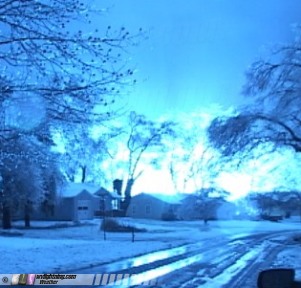 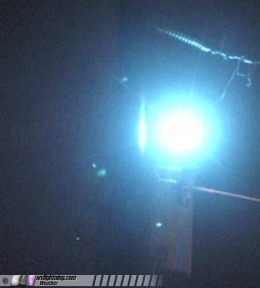
|
In September of 2025, my work is generating the most income it ever has in my career. Yet, I'm being forced to shut down my successul operation, against my will, due to one cause alone: 95% of that revenue is being stolen by piracy and copyright infringement. I've lost more than $1 million to copyright infringement in the last 15 years, and it's finally brought an end to my professional storm chasing operation. Do not be misled by the lies of infringers, anti-copyright activists and organized piracy cartels. This page is a detailed, evidenced account of my battle I had to undertake to just barely stay in business, and eventually could not overcome. It's a problem faced by all of my colleagues and most other creators in the field. |
The weather often wreaks havoc on our nation's power grid. From tornadoes to hurricanes to winter storms, the elevated power system is particularly vulnerable to damage from any number of weather-related forces. When damage to power lines occurs, intense arcing and power outages usually result. The highly visible, bright arcing from a damaged power line is often referred to as a 'power flash'. Power flashes can light up the nighttime sky, and as a result sometimes look like lightning. This article will examine the causes of power flashes and how to distinguish them from lightning.
In This Article:
- Exploding transformer? The causes of power flashes
- Appearance of power arcs
- Responsible weather phenomena
- Lightning or power flash?
Exploding transformer? The causes of power flashes
 Power flashes are almost universally referred to as 'exploding transformers'. However, 'exploding transformer' is an incorrect term, as transformers are rarely the source of these arcs. A 'power flash' is simply an arc caused by a shorted-out power line. These short-circuits can occur anywhere on the power grid where live wires are allowed to contact each other, grounded objects or the earth itself. While power flashes sometimes do occur at an actual transformer, they are typically not associated with one.
Right: Fig. 1 - A small arc occurs above a transformer in Carolina Beach, North Carolina as Tropical Storm Ernesto makes landfall. The presence of the transformer was coincidental, as the arcing was caused by wires above it touching in the high winds.
There are three ways power lines can contact each other or the ground and cause a short circuit and resulting arc:
- Damage or collapse of the wires' support system (telephone poles, insulators or crossarms) due to external force (wind, ice).
- External forces (such as strong wind) causing wires to move and touch each other.
- A conductive foreign object (such as a wet tree branch, bird or squirrel) resting across two live wires.
Below: a tornado produces a power flash as it damages lines near Spearman, Texas

Appearance of power arcs
Power flashes are most visible and dramatic at night. They appear as an intense, sometimes pulsing glow emanating from a source on the ground. The color is usually a combination of blue, green, turquoise and orange - and the colors can change rapidly as the arcing continues. Power flashes can illuminate an entire cloud deck from underneath, which often results in it being mistaken for lightning. The arcing usually lasts for around one second or less, and the sound produced is usually that of a loud gunshot, a loud buzz, or both.
Below: Fig. 2 - Video frame sequence of an intense power flash in a St. Louis neighborhood during the major ice storm of December 2006. Note the shifting colors as the arc continues. Watch a video clip
The power distribution system is designed to automatically detect such short circuits, and large breakers will normally cut power to the affected circuit quickly - limiting the duration of the arc. Since the cause of many short circuits are momentary (such as a lightning strike or a squirrel walking across wires) most of these circuit breakers (called reclosers) are designed to re-energize the lines several times before they completely cut power. If the cause of the short circuit remains, this re-energizing of the lines may result in two or three more arcing events before power is cut fully.
Below: A severe thunderstorm causes a power flash in Chesterfield, Missouri as lines touch in the high winds:
Power arcs are extremely bright, hot and intense, involving up to tens of thousands of amperes of current. They are very destructive to power equipment and are able to melt or burn any material they contact, including metal. Wooden telephone poles and trees are frequently ignited by arcing.
Below: Fig. 3 - Power flashes light up the sky in Melbourne, Florida as Hurricane Frances makes landfall. These power flashes ranged in color from blue, green, red and orange. (click images to enlarge)
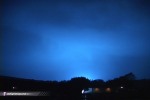 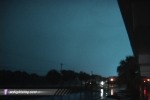 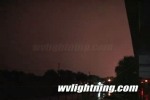
WATCH VIDEO CLIP: Blue/green and red/orange flashes from arcing power lines during Hurricane Frances.
Responsible weather phenomena
While power flashes can result from human-caused incidents (such as a car striking a utility pole), it is the weather that is by far the most prolific producer of damage that results in arcing and power outages.
Tornadoes, Hurricanes & Strong Winds
Wind is the most frequent culprit in causing damage to power lines. Wind can damage lines directly or indirectly. Falling trees and branches can easily topple wires and poles. Airborne debris can lodge in wires, causing a short circuit. Power flashes frequently illuminate the funnels and debris clouds of tornadoes, as the intense winds destroy power lines and equipment.
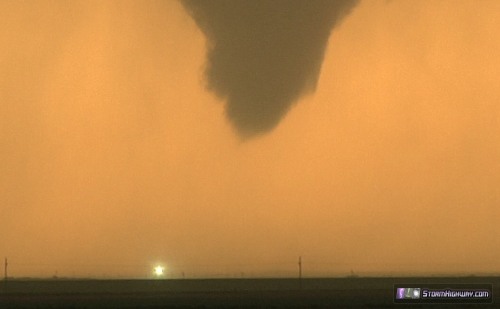
Developing tornado damages power lines near Rozel, Kansas
Lightning
Lightning is another frequent trigger of short circuits and arcs, but in an unusual way. Lightning striking an energized power line can cause a flashover, which is simply the breach of an insulator by an arc. The lightning channel itself acts as a 'starter' for a cross-insulator arc, which continues after the lightning flash is over. These flashovers are common during frequent lightning storms in urban areas. More detail can be found in this article on flashovers.

Video clip of lightning-triggered flashover
Windows Media, 157KB
Ice
Ice storms are very prolific producers of power flashes and widespread outages. The weight of the ice can bring down power lines and poles directly. Ice-laden trees often collapse onto power lines, bringing them down.
VIDEO CLIP: Arcing power lines in St. Louis ice storm
Snow
Heavy snow can indirectly cause power arcs when snow-laden trees and branches fall on lines. Early-season snowstorms that deposit heavy snow on fully-leafed trees are especially known for their potential to produce tree damage and power outages.
Earthquakes
Shaking during an earthquake can cause widespread power line arcing from moving or collapsing power lines. These are contributing to a myth of so-called "earthquake lights" often seen during larger quakes, particularly ones that occur at night.
Lightning or power flash?
Power flashes can often be very similar in appearance to a lightning flash. Adding to the confusion is that lightning itself can trigger a power flash (flashover), causing both to occur together. The following tips can help the observer visually identify the two.
- Observe the color: Color is the most reliable indicator of a power flash vs a lightning strike. Lightning is never green or turquoise in color, so any flash in the sky of that color will indicate a power arc. A flash that changes color is a telltale signature of a power arc.
- Observe the duration: Power flashes usually glow and 'linger' while a lightning strike will flicker rapidly.
- Observe the location: Power flashes usually eminate from a single point on the ground, while lightning will illuminate the clouds more evenly.
- Observe the sound: There will be no thunder associated with a power arc, unless a lightning strike was the cause. A loud buzz or gunshot noise indicates a power arc, although the sound of an arc usually cannot be heard more than a half mile away.
 About the Author: Dan Robinson has been a storm chaser, photographer and cameraman for 33 years. His career has involved traveling around the country covering the most extreme weather on the planet including tornadoes, hurricanes, lightning, floods and winter storms. Dan has been extensively published in newspapers, magazines, web articles and more, and has both supplied footage for and appeared in numerous television productions and newscasts. He has also been involved in the research community, providing material for published scientific journal papers on tornadoes and lightning. |
GO: Home | Storm Chase Logs | Photography | Extreme Weather Library | Stock Footage | Blog
Featured Weather Library Article:
|